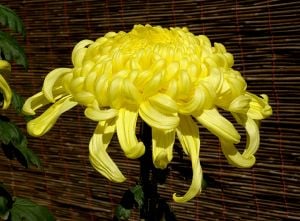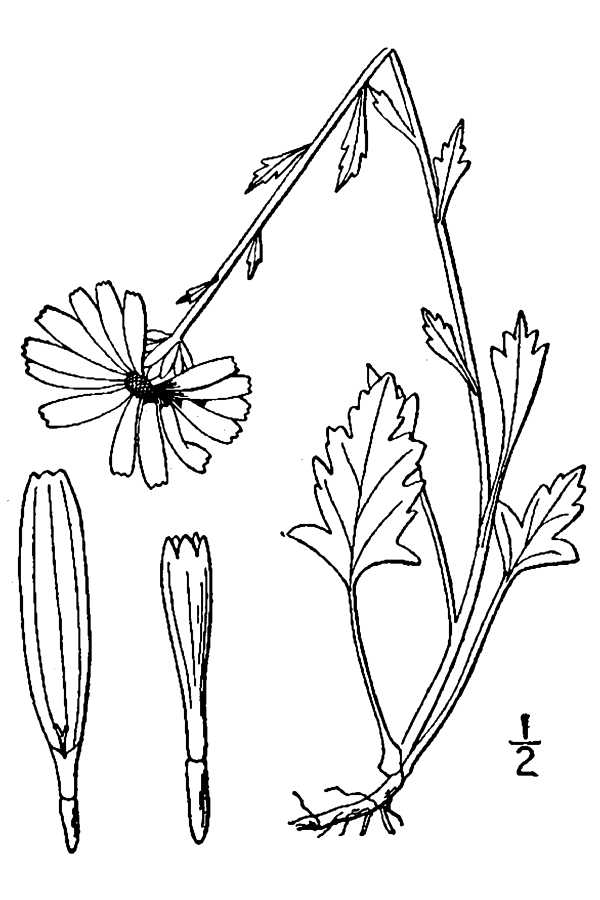History
Imperial Seal of Japan
Chrysanthemums were cultivated in China as a flowering herb as far back as the fifteenth century B.C.E. An ancient Chinese city was named Ju-Xian, meaning «chrysanthemum city.» The chrysanthemum today is one of the «Four Junzi Flowers» (四君子) of China (the others being ume, orchid, and bamboo), known in Chinese as jú (菊).
The chrysanthemum was introduced into Japan probably in the eighth century C.E., and the Emperor adopted the flower as his official seal.
kikukamonshō on Japanese battleship Mikasa
The chrysanthemum (菊 kiku in Japanese) is the monshō («badge» or «crest») of the emperor of Japan today, and therefore the flower represents the emperor and Imperial House. The term kikukamonshō literally means the «Chrysanthemum Crest» (Imperial Seal). The Imperial Seal of Japan is used by members of the Japanese imperial family. However, under the Meiji Constitution, no one is permitted to use the Imperial Seal except the Emperor of Japan. Thus, historically, each member of the imperial family has used a slightly modified version of the seal. Shinto shrines either displayed the imperial seal or incorporated elements of the seal into their own emblems.
The symbol is a yellow or orange chrysanthemum with black or red outlines and background. A central disc is surrounded by a front set of 16 petals. A rear set of 16 petals are half staggered in relation to the front set and are visible at the edges of the flower. An example of the chrysanthemum being used is in the badge for the Order of the Chrysanthemum. The Supreme Order of the Chrysanthemum is a Japanese honor awarded by the emperor. A chrysanthemum appearing in a commoner’s mon, or traditional heraldic crest, would feature 17 petals.
Chrysanthemum ThroneThe gate of Yashukuni shrine
Other members of the imperial family use a version with 14 single petals, while a form with 16 single petals is used for Diet members’ pins, orders, passports, etc.
The Chrysanthemum Throne (Japanese: 菊花紋章, kikukamonshō or kikkamonshō) is the English term given to the Imperial Throne of Japan. In Japanese, it is simply called the Imperial Throne (Japanese: kōi or 皇位). As of 2008, the emperor is His Imperial Majesty the Emperor Akihito, who has been on the Chrysanthemum Throne since his father Emperor Shōwa (Hirohito) died in 1989.
The flower was brought to Europe in the seventeenth century. Linnaeus named it from the Greek prefix chrys-, which means golden (the color of the original flowers), and -anthemon, meaning flower.
ReferencesISBN links support NWE through referral fees

This flower is called Oogiku in Japanese. That means «big chrysanthemum.» The size of this flower is around 200mm.
- Judd, W. S., C. S. Campbell, E. A. Kellogg, and P. F. Stevens. 1999. Plant Systematics: A Phylogenetic Approach. Sunderland, MA: Sinauer Associates. ISBN 0878934049.
- McNeill, J. et al. 2006. International Code of Botanical Nomenclature International Association of Plant Taxonomy (IAPT). Retrieved April 11, 2008.
- Wolverton, B. C., R. C. McDonald, and E. A. Watkins. 2004. Foliage plants for removing indoor air pollutants from energy-efficient homes Economic Botany 34: 224-228. Retrieved April 11, 2008.
Арктантемум арктический, или Хризантема арктическая
Осеннее цветение у абсолютного большинства ассоциируются с яркими кустами-подушками хризантем. Ослепительно броские и неповторимо пышноцветные, они заполоняют все цветочные центры и лавки, красуясь в горшках разнообразием сортов.
 Арктантемум арктический, или Хризантема арктическая (Arctanthemum arcticum). Stauden Stade
Арктантемум арктический, или Хризантема арктическая (Arctanthemum arcticum). Stauden Stade
Многолетние садовые хризантемы приготовили для осени немало сюрпризов. Прекрасные корейские хризантемы и здесь правят балом, но только ими выбор не ограничивается. Самая позднецветущая из хризантем радует совершенно неожиданным для осени цветением – похожими на крупные белые ромашки корзинками.
Хризантема арктическая, как чаще всего и продолжают называть недавно переквалифицированный в род Арктантемум вид, не зря сегодня активно используется в селекции. Растение, которое зацвело бы позже, найти сложно: если выбрать для нее неправильное место, то в регионах с суровыми зимами цветения можно и не дождаться.
Это одна из природно компактных и наиболее аккуратных многолетних хризантем. Ползучие стебли создают удивительно плотные подушки, а глубоко рассеченные темно-зеленые листья только подчеркивают курчавую густоту растения.
Соцветия хризантемы арктической сильно отличаются от любимых всеми осенних неприхотливых «дубков». Они крупные, ослепительно белые и по форме очень похожи на нивяник.
Плоский широкий желтый центр из трубчатых цветов и идеальный ряд ланцетных язычковых цветков образуют типично «летнее» соцветие-корзинку, которое осенью на кустах кажется ослепительным. Соцветия равномерно покрывают куст, удивительно контрастируя с темными листьями.
Традиционно хризантема арктическая зацветает в конце сентября или даже в октябре. Ранняя зима может не позволить насладиться цветением, но при условии выбора теплых площадок эта хризантема является главным украшением сезона, ведь она продолжает цвести и тогда, когда температура опускается до -8 градусов.
Особого выбора по окрасу у сортов хризантемы арктической нет. У растения известен лишь один сорт – «Розеа» с светло-розовыми, нежными и еще более крупными ромашками.
Хризантема арктическая – растение для создания плотных пятен-подушек. Она очень хороша в естественных композициях, прекрасно смотрится в рокариях, альпинариях и на переднем плане миксбордеров. Может она высаживаться и для массивов, и для заполнения почвы, в качестве маскировщика, использоваться для украшения сухих стенок и подчеркивания террасирования.
Вырастить этот вид хризантем можно только на самой дренированной почве, с условием отсутствия риска застоя воды. Хризантема арктическая в средней полосе и севернее лучше себя чувствует на теплых, защищенных, солнечных местах.
Продолжение списка 10-ти самых ярких осенних цветов смотрите на следующей странице.
Description and taxonomy
The family Asteraceae or Compositae, to which Chrysanthemum belongs, is known as the aster, daisy, or sunflower family. It is the largest family of flowering plants in terms of number of species. According to the Royal Botanical Gardens of Kew, the family comprises more than 1,600 genera and 23,000 species. The name «Asteraceae» is derived from the type genus Aster and refers to the star-shaped flower head of its members, epitomized well by the daisy. «Compositae,» an older but still valid name (McNeill et al. 2006), means «composite» and refers to the unique inflorescence (described below).
Asteraceae is a taxon of dicotyledonous flowering plants. In addition to the chrysanthemum and daisy, other well-known members of the family include lettuce, chicory, globe artichoke, safflower, dandelion, ragwort, and sunflower.
Plants belonging to the Asteraceae share all the following characteristics (Judd et al. 1999). None of these traits, taken separately, can be considered synapomorphic.
- The inflorescence is an involucrate capitulum (flower head)
- Tubular/disc florets are actinomorphic, ligulate/ray florets are zygomorphic
- Anthers are syngenesious, i.e. with the stamens fused together at their edges, forming a tube
- The ovary has basal arrangement of the ovules
- One ovule per ovary
- The calyx (sepals) of the florets are modified to form a pappus, a tuft of hairs, which often appears on the mature fruit
- The fruit is an achene
- In the essential oils Sesquiterpenes are present, but iridoids are lacking.
The most common characteristic of all these plants is an inflorescence or flower head (formerly composite flower): a densely packed cluster of numerous, small, individual flowers, usually called florets (meaning «small flowers»). Plants in the family Asteraceae typically have one or both of two kinds of florets. The outer perimeter of a flower head like that of a sunflower is composed of florets possessing a long strap-like petal, termed a ligule; these are the ray florets. The inner portion of the flower head (or disc) is composed of small flowers with tubular corollas; these are the disc florets.
A red chrysanthemum
The genus Chrysanthemum contains about 30 species of plants native to Asia and northeastern Europe. The genus once included many more species, but was split several decades ago into several genera; the naming of the genera has been contentious, but a ruling of the International Code of Botanical Nomenclature in 1999 resulted in the defining species of the genus being changed to Chrysanthemum indicum, thereby restoring the economically important florist’s chrysanthemum to the genus Chrysanthemum. These species were, after the splitting of the genus but before the ICBN ruling, commonly treated under the genus name Dendranthema. The other species previously treated in the narrow view of the genus Chrysanthemum are now transferred to the genus Glebionis. The other genera split off from Chrysanthemum include Argyranthemum, Leucanthemopsis, Leucanthemum, Rhodanthemum, and Tanacetum.
The species of Chrysanthemum are herbaceous perennial plants growing to 50–150 centimeters tall, with deeply lobed leaves and large flowerheads, which are white, yellow, or pink in the wild species. As with Asteraceae in general, Chrysanthemum blooms are composed of many individual flowers (florets), each one capable of producing a seed. Some species and hybrids have only disc florets in the flower head, while others have both ray and disc florets. The ray florets are considered imperfect flowers, as they only possess the female productive organs, while the disk florets are considered perfect flowers as they possess both male and female reproductive organs.
Identification and Information
Arctic Daisy Photos
The arctic daisy (Chrysanthemum arcticum) is a 10-45 cm (4-18 in) tall perennial herb. It grows from a thick creeping rhizome. The plant usually only has a few erect stems or may be single-stemmed. Basal leaves are glabrous, dark green, with 3-7 blunt-toothed lobes. Leaves located distally on the stems are linear and smaller. The synflorescence may have 1-5 flowering heads with white ray florets and yellow disk florets. The ray florets are 1-2 cm in length and fairly broad (3.5 mm).
 RCS PLANTS Database
RCS PLANTS Database
The basal leaf blades of Chrysanthemum arcticum ssp. arcticum are more fan-shaped to cuneate. Chrysanthemum arcticum ssp. polare is typically single-flowered, shorter, and unbranched.
There may also be some confusion with Dendranthemum arcticum which was originally listed as a synonym to Chrysanthemum arcticum ssp. arcticum, thought to be a subspecies of C. arcticum, which is currently listed by the Integrated Taxonomic Information System as a separate species Arcanthemum arcticum. Many other sources such as NatureServe Explorer and GBIF list D. arcticum as a synonym to C. arcticum. If this seems confusing, it’s because it is. Maybe these are two different species, maybe they are not. Regardless, they are at least extremely similar. It seems very possible that many of the Arctic Daisy specimens found in eastern North America are actually Arcanthemum arcticum (aka. Dendranthemum arcticum, aka Chrysanthemum arcticum ssp. arcticum). I’ve found no information on differences in chromosome number, and if the only difference is a slightly modified leaf shape, listing it as a completely separate species seems silly to me. But, admittedly, I am not a biologist so who am I to judge?
Credits
New World Encyclopedia writers and editors rewrote and completed the Wikipedia article
in accordance with New World Encyclopedia standards. This article abides by terms of the Creative Commons CC-by-sa 3.0 License (CC-by-sa), which may be used and disseminated with proper attribution. Credit is due under the terms of this license that can reference both the New World Encyclopedia contributors and the selfless volunteer contributors of the Wikimedia Foundation. To cite this article click here for a list of acceptable citing formats.The history of earlier contributions by wikipedians is accessible to researchers here:
- Chrysanthemum history
- Asteraceae history
- Imperial_Seal_of_Japan history
The history of this article since it was imported to New World Encyclopedia:
History of «Chrysanthemum»
Note: Some restrictions may apply to use of individual images which are separately licensed.
Солидаго
Ослепительно яркое лимонное цветение солидаго как будто впитало в себя последние теплые лучи осеннего солнца и щедро одаривает своей жизнерадостностью начинающий готовиться к зиме сад. .
Солидаго в народе больше известен, как золотарник. Нужно отметить, что одичавший золотарник представляет опасность, как один и самых злостных сорняков. Поэтому выращивать видовые разновидности этого растения, например, золотарник канадский, не рекомендуется. Другое дело — современные гибридные сорта солидаго, которые, благодаря работе селекционеров, значительно ограничены в агрессивности и росте.





























